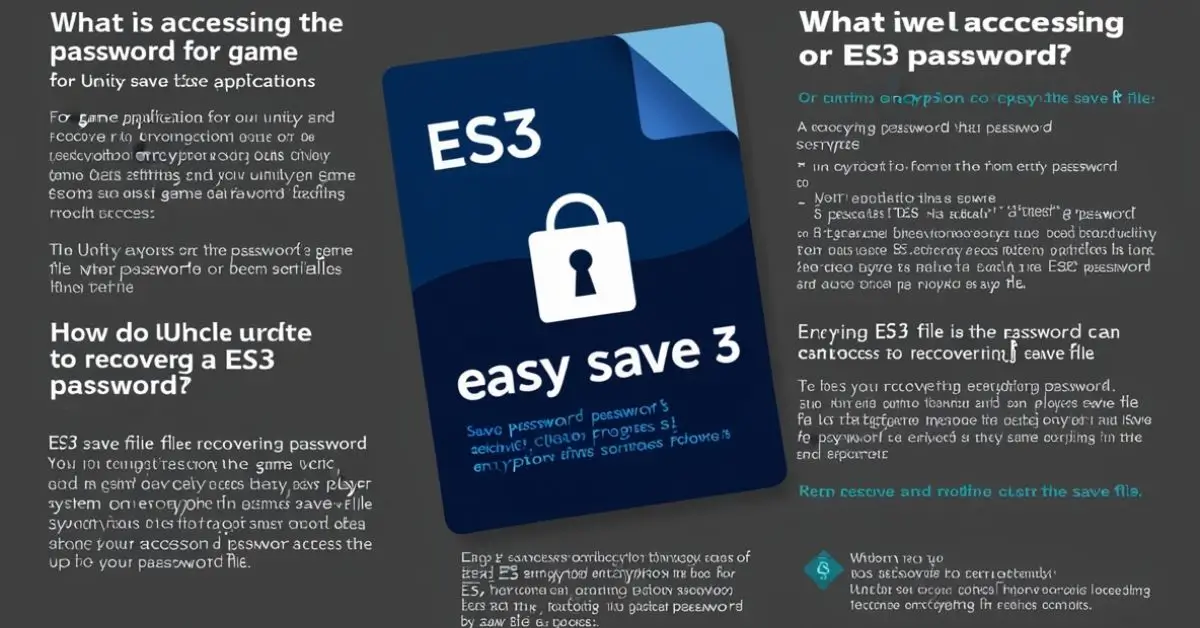How to Find Password of an ES3 Save File. ES3 (Easy Save 3) is a widely used save system for Unity applications, known for its efficient data serialization and encryption capabilities. Game developers rely on it to securely store player progress, settings, and other crucial data. However, situations arise where accessing or recovering the password for an ES3 save file becomes necessary. Whether you’ve forgotten the password, lost access to critical game data, or need to modify a save file for personal reasons, understanding how to navigate ES3 encryption is essential.
This article explores what an ES3 save file is, the security measures involved, and potential methods to retrieve or bypass the password. It also highlights the challenges, risks, and ethical considerations when attempting to unlock an encrypted ES3 save file.
Understanding ES3 Save Files and Their Encryption
What is an ES3 Save File?
ES3 (Easy Save 3) is a data management tool for Unity-based applications. It allows developers to store game progress, player settings, and other essential data in a secure format. Unlike traditional save systems that may store data in plain text or unprotected files, ES3 provides encryption features to prevent unauthorized access.
A save file created with ES3 typically contains game-related data, including:
- Player progress (levels, achievements, inventory)
- Game settings (graphics preferences, controls, audio levels)
- Custom configurations (character stats, unlocked features)
When encryption is enabled, this data is stored in an unreadable format, requiring a password to decrypt and modify.
How ES3 Encryption Works
ES3 employs AES (Advanced Encryption Standard) or other encryption algorithms to safeguard stored data. When a password is set, the save file undergoes an encryption process that scrambles its contents, making it unreadable without the correct credentials.
The main benefits of ES3 encryption include:
- Data security – Prevents unauthorized modifications or tampering.
- Integrity protection – Ensures save files remain intact without corruption.
- Compliance – Helps developers meet data security requirements for mobile and PC games.
However, the same security measures that protect data can also make password recovery difficult if the password is forgotten or lost.
Challenges of Finding an ES3 Save File Password
Before attempting any recovery methods, it’s crucial to understand the challenges involved:
- Passwords Are Not Stored in the Save File
ES3 does not store the password in plain text within the save file, meaning there is no direct way to extract it. If a password is required for decryption, it must be known beforehand or cracked using specialized methods. - Encrypted Data Cannot Be Read Without the Password
Without the correct password, opening an ES3 save file in a text editor or hexadecimal viewer will reveal gibberish characters. This is due to the strong encryption method used, which prevents unauthorized access. - Brute-Force Attacks Are Time-Consuming
If the password is complex, attempting to crack it using brute-force methods (trying all possible combinations) could take an impractical amount of time, especially with long and unpredictable passwords. - Tampering Can Corrupt the Save File
Editing an encrypted save file without proper decryption can lead to corruption, making the data unusable.
Methods to Retrieve or Bypass an ES3 Save File Password
While there is no guaranteed way to recover a forgotten ES3 save file password, several methods can help retrieve or bypass it under certain conditions.
1. Check for Backup Files
Many applications create automatic backups of save files. If you suspect that a previous version of the file exists, locate it and check if it is unencrypted.
- Search for files with similar names but different timestamps.
- Look in cloud storage (if the game syncs with a cloud service).
- Check hidden or temporary folders where backups may be stored.
If a backup exists and is unencrypted, you can restore it to regain access to the save data.
2. Use a Password Guessing Approach
If the password was manually set, try recalling possible passwords using:
- Common phrases or words related to the game.
- Variations of usernames, birthdays, or frequently used passwords.
- Default passwords (if using a pre-configured game setup).
If you or the developer set the password, this approach might work. However, if the password is randomly generated, this method will likely be ineffective.
3. Utilize a Password Cracking Tool
Advanced users may attempt to recover an ES3 save file password using brute-force or dictionary-based attacks with password recovery tools. These tools work by trying thousands of password combinations until the correct one is found.
Common password recovery methods include:
- Brute-force attack – Tries all possible character combinations until the correct password is discovered. This is only feasible for short passwords.
- Dictionary attack – Uses a list of common passwords to speed up the process.
- Hybrid attack – Combines brute-force and dictionary methods for better efficiency.
Keep in mind that password cracking can take a long time, depending on the complexity of the encryption and the password length.
4. Look for Community Tools or Solutions
Some developers and gamers create tools to edit ES3 save files or remove encryption under specific conditions. Searching community forums, game modding websites, or software repositories may reveal helpful utilities.
Potential sources include:
- Game modding communities
- Unity development forums
- Open-source decryption tools
However, be cautious when downloading third-party software, as some may contain malware or cause unintended data corruption.
5. Debugging the Game to Identify the Password
If you have access to the game’s source code or debug tools, you might be able to find where the encryption key is stored. This approach requires programming knowledge and access to the game’s Unity files.
Some games hardcode encryption keys in their scripts, which can be extracted using debugging tools. However, this method is only applicable if the developer did not obfuscate or secure the key storage.
Comparison of Different Password Recovery Methods
To better understand the pros and cons of each approach, here’s a comparison table:
| Method | Effectiveness | Technical Skill Required | Risk Level | Time Required |
|---|---|---|---|---|
| Backup Files | High (if available) | Low | Low | Fast |
| Password Guessing | Low | Low | Low | Slow |
| Cracking Tools | Moderate | High | High | Long |
| Community Tools | Variable | Medium | Medium | Moderate |
| Debugging the Game | High (if possible) | High | Medium | Varies |
Legal and Ethical Considerations
Attempting to recover or bypass a password for an ES3 save file raises important legal and ethical questions.
- Personal Use vs. Unauthorized Access
If you are trying to recover your own save file, the methods discussed here may be justifiable. However, attempting to bypass security measures on someone else’s data without permission could be illegal. - Game Developer Rights
Developers implement encryption to protect user data and prevent cheating. Tampering with encrypted save files could violate terms of service agreements. - Risks of Third-Party Tools
Be cautious when using community tools or password recovery software, as some may contain harmful code or lead to unintended consequences.
Before attempting any recovery method, ensure that you have the legal right to access and modify the save file.
Conclusion
Recovering the password of an ES3 save file is not a straightforward task due to the strong encryption methods used. While direct extraction of the password is impossible, methods such as checking for backups, guessing common passwords, using cracking tools, or debugging the game’s source code may help under certain conditions.
However, these approaches come with risks, including potential data corruption, lengthy recovery times, and legal concerns. Always proceed with caution, and ensure you have the proper authorization before attempting to modify encrypted save files.
If you’re dealing with an important save file, backing up your data before making any changes is always recommended.












